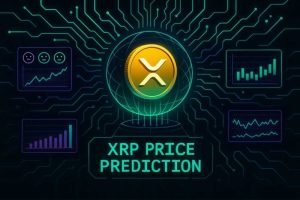Scott Melker, host of The Wolf of All Streets podcast, recently published a tweet emphasizing the new yield opportunities available for XRP through Flare Network.
He wrote, “Yield is here for XRP. Hugo Philion and Jesus Rodriguez break down how Flare Networks is bringing DeFi to tokens that didn’t have it in the past.”
The tweet captions a podcast episode in which Hugo Philion, co-founder of Flare, and Jesus Rodriguez, co-founder of Sentora, discussed how Flare creates decentralized finance applications for XRP and other tokens that have not had access to such markets.
Yield is here for $XRP. @HugoPhilion and & @jrdothoughts break down how @FlareNetworks is bringing DeFi to tokens that didn’t have it in the past. https://t.co/TuuBOwKlV2
— The Wolf Of All Streets (@scottmelker) August 16, 2025
Philion explained that Flare operates as an independent layer-one blockchain, designed with integrated data protocols that provide decentralization at its core.
According to him, these data protocols form the foundation for enabling DeFi functions for assets like XRP. He noted that XRP, despite its prominence in the digital asset market, has been largely overlooked in terms of DeFi integration.
Flare aims to change this by providing an EVM-compatible environment where developers can build applications, thereby unlocking new financial use cases for XRP holders.
Turning XRP into a Yield-Bearing Asset
During the interview, Melker asked whether the introduction of XRP into DeFi primarily meant yield opportunities. Philion confirmed this, outlining use cases where XRP could be deployed in lending platforms, decentralized exchanges, or collateralized stablecoin systems.
For example, XRP holders could use their assets as collateral to mint stablecoins, which could then be reinvested across DeFi platforms to generate returns. He emphasized that this approach allows XRP, which traditionally does not generate yield, to be transformed into a yield-bearing asset.
Rodriguez expanded on this by discussing the role of Sentora’s product, Firelight, which is being developed on Flare. He described it as a structured platform for managing risk and optimizing strategies for institutional and retail participants.
He explained that strategies could include supplying XRP, borrowing stablecoins, and deploying those assets in yield-generating opportunities. He stated that this system is designed to address risks such as liquidation and slippage, making it suitable for both institutions and sophisticated retail users.
Institutional and Retail Access to DeFi
Melker raised the question of whether Flare’s products are designed primarily for institutional investors. Philion responded that while institutions are an important focus, Flare also intends to provide access to retail holders, many of whom own significant amounts of XRP.
He says that Flare’s emphasis on decentralization and neutral data sources makes it attractive to institutions, as the built-in Oracle systems reduce risks associated with centralized data providers.
Rodriguez added that the concept of “institutional-grade” infrastructure should not exclude retail investors, as robust security and efficient execution are beneficial for all participants. Both guests agreed that the goal is to create systems that serve institutional requirements while also being accessible to the wider crypto community.
Yield Projections and Non-Custodial Infrastructure
In terms of yield, Rodriguez stated that initial estimates suggest XRP holders could earn between 4% and 7%, depending on market conditions and the strategies employed. He emphasized that these opportunities would be available through non-custodial protocols, meaning users maintain control over their assets unless they choose to interact through custodial platforms such as exchanges.
Philion reinforced this point by highlighting Flare’s focus on non-custodial bridges, such as FXRP, which allow XRP to move onto the Flare blockchain without centralized intermediaries.
We are on X, follow us to connect with us :- @TimesTabloid1
— TimesTabloid (@TimesTabloid1) June 15, 2025
Broader Implications for DeFi
The conversation concluded with a discussion of how the ecosystem around XRP and other non-yielding tokens could expand once DeFi opportunities become established. Philion said Flare is working to build a wide DeFi environment that includes lending, stablecoins, and decentralized exchanges.
Rodriguez noted that one of the longer-term goals is to support innovative applications, such as DeFi insurance, which could offer additional ways for XRP to generate returns. Both emphasized that the collaboration between Flare and Sentora seeks to provide a sustainable framework for yield generation that can serve both retail and institutional participants.
Melker’s tweet and the subsequent podcast highlight a notable development for XRP, as Flare Network moves to provide yield-generating opportunities to an asset that historically has not had access to decentralized finance.
With non-custodial infrastructure, integrated data protocols, and partnerships focused on institutional-grade solutions, Flare positions itself to open a new chapter in the utility of XRP within the DeFi sector.
Disclaimer: This content is meant to inform and should not be considered financial advice. The views expressed in this article may include the author’s personal opinions and do not represent Times Tabloid’s opinion. Readers are advised to conduct thorough research before making any investment decisions. Any action taken by the reader is strictly at their own risk. Times Tabloid is not responsible for any financial losses.
Follow us on X, Facebook, Telegram, and Google News
The post XRP Yield Is Here: How Flare Brings DeFi Applications for XRP Holders appeared first on Times Tabloid.



